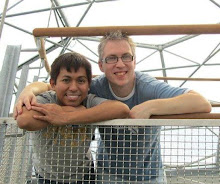 |
| Schefflera digitata |
The shorter daylight hours in the winter has both bad points and good points; bad being that you only have a short amount of time to get crackin' in the garden with natural light, and good being that at least you are forced to pack up and head indoors much earlier and do something else. Artificial lights are never the same really, you get to see better detail with natural daylight.
In the summer we can continue outdoors till nine in the evening, now we start packing up just before four. I'm still getting used to the routine of being indoors relatively early but it's good to be able to catch up on a few more 'indoorsy' activities that gets sidelined in the summer. Mind you, we don't exactly stay indoors most of the time. Four pm is still early and there's plenty of time to go shopping and places after being in the garden, fantastic!
By the way, if the title seems disjointed it's because this entry is actually a small collection of updates of what we got up to last weekend. It'll make sense pretty soon!
The Heart of the Pond
The pond build continues but with the shift in season and temperatures we have to focus on the wood work aspect of the build, and that includes the Filtration House. It was just the two of us this time as Dad was unavailable last weekend but we were still able to do plenty. Most of the thinking, hammering, and sawing is done by Gaz and my role is mainly to just pass things around and hold things in place as he hammers away. My role is not as physically intense compared to the other aspects of the project but I regard it as just taking a rain cheque, considering how much hard labour I've put in sorting the base.
One of my colleagues at work christened this part of the built as building the 'Heart of the Pond'. As romantic as that may sound, it's not really the heart of the pond but more like the ribcage. It will be the Ribcage that will enclose and protect the three Hearts (pumps), Lungs (aeration), and Livers (filtration); and it is these hearts that will keep the entire Vascular System (pipework) circulating and making sure that the water is at it's best for the health of the fish and clarity of water.
The Filtration House is very much part of the design and plan of the overall area and deserves it's own dedicated attention. I somehow underestimated the amount of time needed to build this but it's clearer to me now that this will take much longer than I expected. There's actually a lot to, both inside and and out, aesthetic and functional bits.
So far so good, the main timber frame of the walls and roof are already built and the waterproofing membrane has been fastened, bar the apex of the roof which has been left open to let more light in temporarily. We have now started putting up the exterior cladding which will be the face of the structure.
Funny enough, most of the cladding work that was done last Saturday was to the back of the structure facing our neighbour's garden so at the end of the day it looked like nothing was done. On Sunday we were able to do most of the left side facing the temporary greenhouse and most satisfying of all, have started the front of the building. After days of building the Skeleton (timber framework), it's great to see the Skin and Face slowly unravelling. But unlike real anatomy, Muscles and Fat (insulation) won't be applied until much later on when the Skull Cap (roof) has been applied and the interior is mostly watertight.
Treasures in and out of the Greenhouse
It's not all building works that we did last weekend, we also had time for some gardening as well. First was I started grouping some of the plants that are likely to be planted out on to the raised beds which includes the lovely Buddleja 'Silver Anniversary' that has matte and silvery leaves which will reinforce the colour scheme of the first raised bed; and Edgeworthia chrysantha which has lovely, bluish foliage that will be perfect for the second raised bed, with the blue tone picking off the scheme from the first raised bed.
 |
| Buddleja 'Silver Anniversary' |
 |
| Edgeworthia chrysantha |
And then on to the greenhouse. It always makes me smile that whenever we have visitors they are just as curious as what's inside our greenhouses as to what we have growing outside. The temporary one is jam packed for the winter and I took some time to do some tidying up, removing dead leaves that may attract excess fungal growth if left in situ, as well as some watering. I've also done some rearranging to accommodate a few more plants in, like a Dichroa febrifuga and three pots of seed grown Schefflera digitatas.
 |
| Dichroa febrifuga |
 |
| Schefflera digitata |
Hmmmm.....Two days and six hours each day. Not bad! :)

















































 This gardening blog follows our journey as we create our Tropical and Exotic themed garden. We hope you'll enjoy the journey as much as we do. We started our Exotic Garden in 2005 and this site will show its development, as well as our travels, both abroad and within the UK to gardens, nurseries and friends.
This gardening blog follows our journey as we create our Tropical and Exotic themed garden. We hope you'll enjoy the journey as much as we do. We started our Exotic Garden in 2005 and this site will show its development, as well as our travels, both abroad and within the UK to gardens, nurseries and friends.








